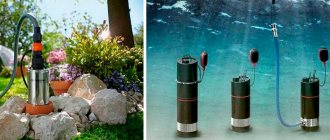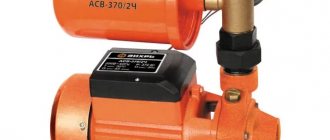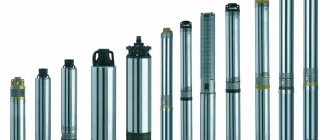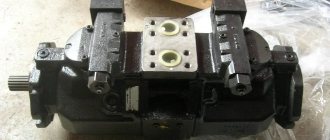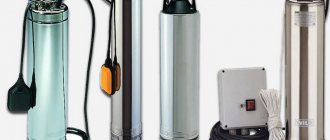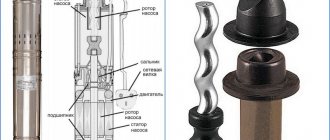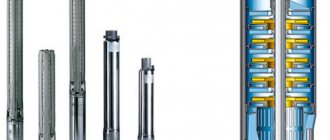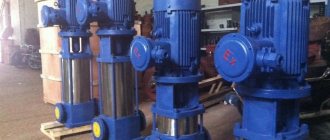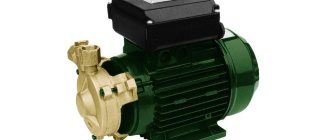The situation when submersible equipment gets stuck in a well is not uncommon. And the reasons for this may be different. Let's look at how to get the pump out of the well in any case on your own, without resorting to the services of specialists. We will also look at common mistakes that are made due to illiteracy.
Trap for a stuck pump Source septik27.ru
Emergency
Getting a pumping device stuck in a well is, to put it mildly, not a pleasant situation.
It usually occurs when trying to lift the device to the surface for routine maintenance or repairs. As a result, a stalemate arises: the pumping equipment does not work and it cannot be repaired either, because there is no access to it. In some cases, you will be able to independently remove the pumping equipment from the well without damaging it, but sometimes you have to say goodbye to the pump. In the most extreme situation, the water well is completely out of order.
Getting a pump stuck in a well is an emergency
Siltation
The device may jam due to silting
In addition to the usual, reverse siltation can also occur. This usually happens in a well made on limestone, which is quite hard. The reason for this silting is a pump installed too deeply. As a result, the liquid in the well stagnates and is very poorly renewed. The salts contained in it combine with iron particles and, with oxygen, pass into the surface layer, precipitating. This sediment covers the top of the apparatus and pipes. As a result, the device gets stuck in the well.
To prevent this phenomenon, it is necessary to remove the unit from the mine every 5 years and correctly select its location at the bottom. If clogging with sand occurs and the device is firmly jammed, you need to turn it on and slowly rock it. Then he will come out easily.
How to prevent pump lifting problem
Pulling a deep well pump out of a well with your own hands if it comes off is not at all difficult if you follow all the recommendations of specialists.
The catchphrase is: “Forewarned is forearmed.” To prevent unpleasant situations from occurring, you need to follow a number of simple rules that can save equipment, time and money.
- Work only with strong cables. You can't skimp on this item. Choose quality products and fasteners.
- The hose must be intact. Buy one of sufficient length, even if the one included in the kit does not meet the required parameters. This will reduce the risk of breakage significantly.
- Choose the right size. The unit should be one third of the diameter of the pipe. Otherwise, congestion during lifting cannot be avoided.
- Set the header. This will ensure “protection” of the well from unwanted “guests”: garbage, bottles, stones, boxes.
General recommendations for safe lifting
It is easier to prevent a stuck submersible pump than to correct the problem later.
To do this, you need to follow a few simple recommendations:
- Use a reliable, strong and rigid cable . The cable that comes with the submersible pump often does not meet these requirements. Don’t skimp, buy a high-quality cable and fasteners (clamps) made of stainless steel.
- Do not use multi-piece hose . If the hose included with the pump is not long enough, you should not extend it; it is better to buy a new one in one piece. This will reduce the risk of breakage and serve as additional insurance if the cable breaks.
- Select the correct pump size . It should be 2/3 smaller than the diameter of the casing pipe. Thus, the risk of the unit jamming will be significantly reduced even if the pipe is deformed or foreign objects fall into the well.
- Be sure to set the header . It will protect the well from falling debris and various objects.
And remember: when using the methods described above, under no circumstances use brute force when trying to pull the unit to the surface. This will lead to aggravation of the problem: the pump will get stuck even more tightly inside the barrel, the cable may break, and the wall and casing may become deformed.
Lifting the submersible pump, as well as all actions aimed at removing the stuck unit, must be carried out together with an assistant; it is impossible to remove the stuck pump alone
Causes of the problem and solutions
There is one common reason why the pump becomes difficult or even impossible to remove from the well. This is non-compliance with the technological requirements for the construction of the well itself and the mounting of equipment in it, as well as improper operation of the water source. If the instructions were strictly followed during this work, dismantling the device will be easy and simple.
What leads to such consequences?
Siltation of a sand well
But it is even more important to equip it correctly, starting with the manufacture of the casing, which must be perfectly straight, with smooth inner walls
- Install sediment in the well of such a diameter that the gap between its body and the pipe walls is sufficient. It will cost more than larger analogues, but its price cannot be compared with the cost of equipping a new well.
- To install submersible equipment, use only a strong, high-quality stainless steel cable, securely attaching it to the device.
- Neither the hanger nor the pressure hose must be spliced from separate sections. They may separate when lifting the pump; pieces will fall down and jam it, preventing free movement.
- To prevent the electrical cable from sagging, secure it with clamps to the hose before starting to lower the device into the well.
Types of waterproofing
Moisture is the enemy for builders. If water penetrates into structures, they will quickly become unusable. The same goes for the pool. There is water inside it, but it should not penetrate the walls. Therefore, the entire structure must be reliably protected. For this, two types of waterproofing are used:
- external;
- internal.
The outer layer is required to protect the pool bowl from moisture penetrating from the surrounding soil. For this purpose, special additives are used that are mixed with cement. Therefore, external waterproofing is carried out at the construction stage. Internal moisture protection covers the bowl itself and protects against penetration of water poured into the bowl into the supporting structures. It is performed before finishing.
What to do if the pump gets stuck in the well
Getting a pump stuck during lifting, as already mentioned, is not such a critical situation, and if lifting is not carried out by professional well service specialists, then the first thing to do is be patient and pull yourself together; panic in this situation can only aggravate the problem.
A simple analysis of the situation will help you quickly determine the causes of equipment failure and choose the optimal way to solve the problem. To do this you need:
- find out the total installation depth of the pump;
- approximately determine the depth of the jam;
- analyze how tight the cable is, determine whether the pipeline and pump are disconnected and the integrity of the power cable.
- inspect the head of the casing pipe;
- prepare the necessary tools for work;
- clear the area of foreign objects.
This algorithm of operation makes it possible to significantly reduce the time required to prepare for lifting equipment and prevent larger mistakes in the future.
Why did it happen
What led to this situation? First of all, as mentioned above, you need to understand the reason.
How to remove a pump from a well with a working cable
This situation can only arise in shallow sand wells. If the inside is overgrown with silt, which, when dried, turns into a solid substance, then it must first be soaked. To do this, water is poured into the pipe through the head in small portions (1-2 buckets), while the pump is swung to the sides using a cable. After a while, the softened sludge will flow from the side walls of the device to the bottom and the device can be pulled out. Soaking the sludge can take from several hours to a day, depending on the degree of overgrowth of the well.
When overgrown with limestone
This situation occurs in “limestone” wells, which themselves are very deep, plus limestone dissolves much worse than silt. You can remove the pump from the well yourself by treating the deposits with special household products for removing scale from kettles, dishwashers or washing machines. The dry powder must be dissolved in the amount of hot water indicated on the pack and the solution must be poured into the well head. At the same time as pouring the solution, turn on the pump so that the water around it begins to bubble. If you pour in quite a lot of solution, and this will require 10-20 packs of descaling agent, then the limestone will begin to dissolve, and the device can be pulled to the surface without any problems. If the experiment is not successful the first time, it should be repeated several times every 5-6 hours.
Descaling agent
If foreign objects enter
How to get the pump out of the well in this case? Only by rocking the pump in the hope that a stone or other obstacle will slide down and stop preventing the pump from being pulled out. You can try lowering a separate long rigid cable into the well with a metal rod attached to the end. You need to try to push the obstacle down with this rod. To avoid foreign objects getting into the well neck, it must be securely closed.
When the electrical cable sag
If the cable sag, you must proceed according to the following algorithm:
- Using a safety rope, lower the device to the very bottom and very carefully try to align the loop. To do this, you need to swing the cable in different directions, while simultaneously pulling it up.
- Equalize the tension of the cable, cable and water hose. It is better to do this with an assistant who will pull all three elements away from the mouth.
- In the place farthest from the neck, fix three long components together. Fixation should be carried out in other places of their parallel location. Fasten the cable, cable and hose with clamps every 1-1.5 m.
- Pull out the pump and connect together those parts of the cable, cable and hose that were located in the depths.
Pulling the pump out of the depths and equalizing the tension of the cable, cable and hose using clamps
Removing with a slack cable
A pump that suddenly stops moving upward is often the result of a loose cable that has become wrapped around the housing and prevents the equipment from moving further. In this case, you need to carefully lower the device down and smoothly remove the slack in the wire. Once the pump casing is freed from entanglement, lifting again should begin. Sagging of the cable, rope and hose must be avoided.
To prevent a similar problem from happening in the future, the power cable should be secured to the pressure hose using special clamps. Each time the pump is lifted, they will have to be removed and new ones installed, but such efforts will help to avoid emergency situations.
How to get a broken pump out of a well
A broken cable is the most difficult case. If in the situations described above the device is pulled out using a cable, then if it breaks, you will have to pull the water supply hose or the electrical cable. They are also attached to the device, but are not intended to require significant physical force. You can use this method if the pump in the well “moves” freely and is light in weight. If it is heavy, then it is better not to risk it, lower a strong rope with a metal hook tied to it into the pipe. Use this hook to hook the pump and pull it up. In this case, the hose and cable can be used as insurance if the hook comes loose.
You can get a well pump yourself if you know exactly the reason for the jamming. Since the device is located at depth, it is almost impossible to carry out diagnostics yourself. Incorrect actions when lifting the device are also fraught with serious consequences. To prevent this from happening, you should turn to professionals - they have special video equipment for diagnostics. Having determined the cause of the stuck pump, specialists will remove it from the depths using professional tools.
The normal functioning of an individual water supply system for a private house with a well pump depends on many factors, including how correctly and timely the equipment is maintained. External inspection of pipelines and joints, pressure monitoring and recording the volume of pumped liquid, changing filters, all this significantly extends the life of the equipment, but among all these operations, the most labor-intensive operation still remains the maintenance of a deep-well pump, during which non-standard situations are possible, for example, when the pump It just might get stuck in the well.
From simple to complex
For deep-well pumps that have a large diameter and short length, the connection of which is carried out via a flexible polyethylene hose, and these are most often vibration pumps, during lifting a situation may arise when the electric cable of the pump gets caught between the pump housing and the wall of the casing pipe.
Such pumps are most often lifted by a cable and a hose, but the cable, the entrance to the pump body, which is located below the level of the hose connection and the cable fastening, is simply tightened periodically. At the moment when the cable is most weakened and has excessive length, it fixes the rise of the entire structure. The small distance between the housing and the wall into which the cable enters becomes a big obstacle to removing the equipment to the surface.
In fact, this is the simplest of all possible cases of jamming during lifting. The problem here can be solved quite simply - just lower the pump a little into the well and at the same time tighten the cable. After tensioning the cable, continue lifting, ensuring the tension of all elements - hose, cable and cable.
What to do if the pump cannot be removed
If the electric pump cannot be removed to the surface after all operations (it has become detached from the pressure pipeline, hose with cable), proceed in the following ways:
They continue to use the well source. The bodies of most centrifugal electric pumps are made of stainless steel, and the internal parts are made of polymers or corrosion-resistant metals. The materials are designed to supply drinking water, so the presence of fallen electric pumps at the bottom of a well for many years is unlikely to affect its quality.
The greatest danger to humans is oil, which is present in the mechanism of almost all pumping units; over time, it can leak through a damaged housing. Also, stainless steel in budget models, usually of low quality, can become rusty over time, affecting the quality of drinking water.
The body of the vibration pump is made of aluminum, which is not susceptible to corrosion, the internal parts consist of rubber and steel, and the mounting bolts are also steel - they are susceptible to corrosion over time.
The well is being mothballed and a new one is being drilled. If the owner cares about his health, the service life of the old well source is coming to an end, you can drill a new well relatively inexpensively - in these cases, the old one is mothballed or liquidated.
Breaking an electric pump with a drill. The operation is permissible if the pump is stuck in deep artesian wells with internal steel casing and the pressure pipe is torn off, if the unit prevents the source from filling with water. It will not be possible to push the electric pump deeper - a standard artesian has a tapering channel at the bottom.
After the electric pump is destroyed by a drill, its small parts fall into the artesian water basin through a filter pipe that does not have a lower cap. Over time, the oil will wash out and small parts will sink to the limestone bottom.
Rice. 14 Example of removing a pump along with a casing pipe
Work production technology
Before you remove the failed pump with your own hands, you need to prepare the necessary materials and tools. Their list will be given below. After this you can start working.
If the unit has fallen to the bottom along with the hose, then the procedure for performing rescue measures is as follows:
- A rod called a “cat” is used. This is a steel hook, the end of which must be sharpened.
- Then the end of a steel wire is electrically welded to the cat.
- The second end of the wire rope is tied to the crane boom.
- The hook is lowered into the hole, making rotational (like screwing in a screw) movements. This is necessary to hook the hose. Usually such work has to be done blindly.
- If you manage to hook the hose, you can try to remove the pump unit with a lift. Lifting must be done slowly, otherwise the engagement may break.
It is recommended to take insurance when performing work. There is no need to skimp on a metal cable, since if the quality of the material is poor, it will simply break. Therefore, you need to buy a high-quality stainless steel cable.
When removing the pump, do not use a cable made of several parts. During lifting, the joints may burst and the unit will get stuck in the well.
For prevention, buy a pump with the smallest diameter possible, then the possibility of the unit jamming during lifting will sharply decrease. Such models are more expensive than conventional units, but if you skimp, you will have to drill a new well in the event of an accident. It is recommended to install protective equipment over the well; this will prevent foreign objects and debris from getting into the well.
The most common reasons for pumps getting stuck in wells
Based on the experience of the repair and restoration work carried out, we can identify the most common causes of pumping equipment getting stuck in wells.
The cable that supplies the pump with electricity can have different degrees of tension with the cable that secures the device in the pipe. Slack cables can form a loop that gets into the gap between the pump and the cable wall and jams it.
Secondly, the reason may be the unsatisfactory condition of the internal volume of the well.
During operation, a layer of silt or lime deposits may form in it, which, like a cork in a bottle, clogs the pumping equipment in the mine.
Thirdly, this is the entry of foreign objects into the well shaft.
If the well head is not adequately protected, stones or branches may fall into it, which will not only jam the pump housing itself in the pipe, but also become entangled in the cable or power supply cable.
Construction of a well with a deep pump
Water well drilling process
Everyone is interested in how we will drill a well, how we will carry out the work, and whether we will spoil the landscape of the site. Especially for this, we have prepared for you a photo report of the well drilling we carried out.
| To enter the site, a large turning angle is required for drilling equipment; in this case, the gate interferes with free passage. Gates and fences need to be removed. | The fence sheathing is removed. |
| Now you need to cut off the supporting structure of the fence. We are dismantling the supporting structure. | |
| In order not to damage the base of the fence, and, naturally, the wheels of the equipment, the protruding parts of the supporting structure are covered with boards and sprinkled with sand. | They arrive at the site: a drilling rig with a kung (where the drillers live), and a water carrier (visible in the background). It is necessary to place the kung either on the site, which in this case is unrealistic, or find a place by agreeing with the management of SNT and place the kung there, supply a 220V power supply (extension cord) for living. |
| After dismantling the fence, the car can freely enter the site. | We brought the equipment to the place where the well is planned to be drilled. |
| A pit is dug for the process solution. With the help of which drilling will take place. The pump takes the solution and delivers it through the working tool to the drilling tool. | The boom is raised and, with the help of supports, centered above the drilling site. |
| The technological solution (water + cement) is poured into this pit. | The pump is turned on and with its help water is taken from the existing source and pumped into the pit. If there is no source, water is taken from a water tank. |
| A trench is dug from the drilling site to the pit so that when drilling, water flows into the pit. | The process has begun. The pump pumps the solution, delivers it to the drill, under pressure the solution rises to the surface and enters the pit through the chute. (Solution circulation). |
| A working “table” for drilling tools is set up. The rods are folded onto it, with the help of which drilling is carried out. | The process is still going on. |
| Drill rods, with the help of which drilling occurs and by which we measure the depth of the well. | Later the pipes are delivered. |
| The required number of casing pipes is laid out. | Steel pipes are lined to limestone. |
| Drilling tool (cone cutter). | Extension of casing string. |
| Pipe alignment. | Limestone is exposed through the casing (with a smaller diameter). |
| Aquiferous limestone. | The drilling foreman looks at what fraction (stones, sand, clay, etc.) comes out of the well. |
| When drilling is completed, the working solution is removed to fill the pit. | In this case, they dug a canal from the pit towards the road. If it is not possible to dig a channel, then the solution is pumped out with a pump into a storm drain or another predetermined place. |
| The well is ready. It is welded to prevent foreign objects from getting inside the well. | Drilling is completed, the equipment leaves the site. |
| We restore the load-bearing structure of the fence (welding work). | Restored fence. |
| Restoration of the site (leveling). | The place where the pit was. |
| The well is ready. We are waiting for the arrangement. | |
Main causes of deep-well pump getting stuck
Most often, a pump getting stuck in a well casing is associated with several factors, each of which is unique in its own way, and the ability to solve the problem of stuck equipment is not always justified using a universal technique. On the other hand, the situation when a pump cannot be lifted to the surface is not so unique; cases when equipment is difficult to remove from underground occur quite often and therefore this does not pose a particular problem for professionals.
Schematically, the situation when the pump somehow gets stuck in the well cavity is quite simple, and can be considered in the most common situations:
- Jamming by a weakened electrical wire;
- Breakage of the cable on which the equipment is suspended during lifting;
- Entry of a foreign object into the cavity between the casing wall and the pump housing;
- Deformation of the pump housing or pipe walls;
Most often, as practice shows, we encounter such situations with equipment that has not been serviced for a long time, so when planning maintenance, it is necessary to pay attention to this factor.
Casing pipe deformation
The process of deformation of the casing quite often occurs due to soil displacement or activation of underground sources, the transformation of a simple underground stream into a seething stream or even a river. Such changes in the structure of the soil in the area are not immediately noticeable from the surface, but in relation to the well, a large number of problems arise here.
For wells with a metal casing, deformation is most often expressed in a change in the internal cavity of the pipe - crushing, bending or fracture. For wells with asbestos-cement casing pipes, the material is destroyed, the couplings crumble, and soil gets into the well.
For wells with casing made of PVC pipes, bending or compression is most common, as a result of which it becomes difficult to lift the pump.
The optimal solution in such circumstances is to turn to professional builders to remove the equipment. Only if you have all the necessary arsenal of search equipment, from a remote video camera to a multi-section rod with hooks, in such a situation it becomes possible to get the pump.
However, when the well is relatively shallow, only 8-10 meters, you can construct a sectional rod with hooks at the end to remove equipment from a profile pipe and try to independently conduct exploration and remove the pump.
Usually, the distance to the point of deformation of the barrel is first determined, then an approximate calculation of the internal cross-sectional area is made and the possibility of extraction through the narrowest point of the pump bend is analyzed, and only after that it is lifted.
What factors need to be taken into account?
Usually a well on a site is drilled to a great depth, so removing the casing pipe from it is not an easy task.
Before deciding on such an event, you need to clearly know the answers to the following 6 questions:
- what is the casing pipe made of?
- product weight;
- at what depth is its base located;
- how much time has passed since its foundation;
- under what conditions it was used;
- Is there a good enough reason why it needs to be dismantled?
It is possible that the dismantling work will turn out to be so complex, labor-intensive and financially expensive that it would be more rational not to solve the problem of how to get the pipe out of the well more easily and quickly, but to abandon this idea in favor of deciding to install a new water source.
Rules for installing the surface version
Surface pumps are not often used for this type of water supply as they are only suitable for shallow hydraulic structures, up to eight meters deep.
And yet, this option has a right to exist, and its installation is no more complicated than installing submersible equipment.
Surface pumps are easier to install and cheaper than submersible models, but they are only effective for wells up to eight meters deep
Mount the device as follows:
- The surface pump is installed in a special caisson or a separate room.
- A hose of suitable length is connected to the suction pipe of the pump.
- A check valve is attached to the other end of the hose (a protective measure to prevent water from draining when the pump stops running).
- A protective strainer is installed on the valve to prevent various contaminants from entering the pump housing.
- The hose is lowered into the well.
At this point, the installation can be considered complete and a test run of the pump can be done. To install such a pump in a well, a special adapter is often used. In this case, the hose is connected to the adapter, and the adapter is connected to the pump. The rest of the installation procedure is exactly the same.
It is a little more difficult to install a surface pump equipped with a remote ejector into a well. In this case, two hoses need to be lowered into the well. In addition to the suction hose, a pressure hose is also installed. It is connected to the side fitting of the ejector using a special outlet.
In addition to the check valve and filter, an ejector must also be installed at the end of the suction hose. It should be remembered that surface pumps are very sensitive to contaminants in the water supplied from the well.

